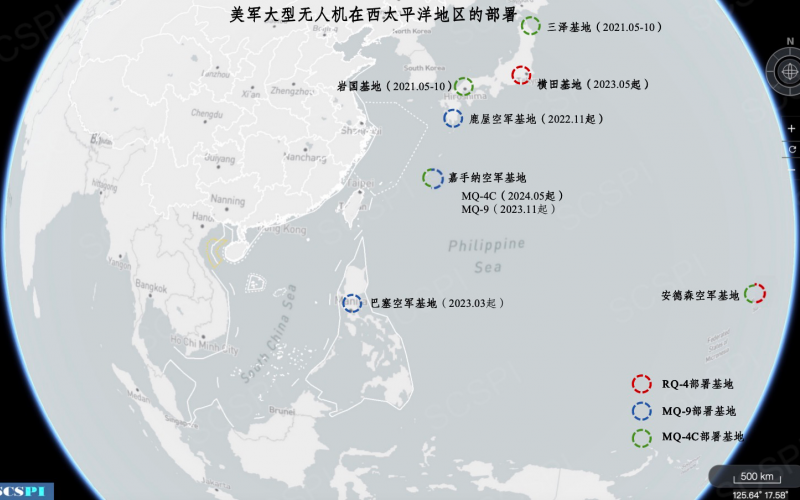MILITARY POSTURE
2025-09-16 | BY SCSPI
Through the RQ-4’s high-altitude strategic early warning, the MQ-4C’s wide-area maritime surveillance, and the MQ-9’s tactical support and strike capabilities, the U.S. has established a layered and collaborative large-scale UAV ISR network in the South China Sea and its surrounding areas.
2025-08-11 | BY Bao Yinan , Zheng Zhihua
This article will analyze the legal nature of the actions of the Xue Long 2 and the USCG aircraft involved in this incident. It will then examine the legal uncertainties surrounding the U.S. claim to an “extended continental shelf”, thereby revealing the “double standard” inherent in the U.S. authorities’ version of “freedom of the seas” and its nature of running counter to the international rule of law.
2025-03-25 | BY SCSPI
In 2024, the US military continued to strengthen its military deterrence against China, maintaining high-intensity operations including close-in reconnaissance, Taiwan Strait transits, forward presence, strategic cruising, military exercises and drills, as well as battlefield preparation in the South China Sea and its surrounding areas. Among them, large reconnaissance aircraft conducted about 1,000 missions, and ocean surveillance and measurement vessels accumulated 706 ship days of activity, marking a significant increase compared to 2023. Carrier strike groups (CSGs) have entered the South China Sea 8 times, demonstrating a strong presence. At least 11 nuclear attack submarines, two guided missile submarines and one ballistic missile submarine appeared in the region throughout the year, signaling a clear deterrence intention. Additionally, the number of batches and sorties of bombers entering the South China Sea has significantly increased, with frequent exercises of “north-south double” and “distributed operations”.
2025-01-18 | BY Hu Bo
In the South China Sea, three types of contradictions—maritime disputes, geopolitical competition and rules and order games—will persist in the long term and continue to escalate. Meanwhile, with an increasingly strengthening influence and power to control the situation, China may lack the ability and conditions to resolve the issues in the short term, but is competent to manage the situation.
2024-10-30 | BY SCSPI
In MDA, the Philippines heavily relies on external support whether on equipment, platforms, systems or data. Despite acquiring quite a few new equipment, platforms and programs in recent years, a cohesive capability has not formed yet, leading to struggling progress.
2024-10-28 | BY Zheng Zhihua, Yan Pan
The Philippines is attempting to exploit the legal ambiguity to advance its territorial expansionist agenda by issuing contradictory statements regarding 'a commissioned warship,' 'a permanent station,' and 'low-tide elevation that cannot be be appropriated or subjected to sovereignty claims'. This strategy to disguise its territorial expansionist intentions by exploiting legal ambiguity is simply an attempt to conceal its true motives. Such disingenuous behavior must be scrutinized and addressed.
2024-09-26 | BY SCSPI
In recent years, driven by US attempts to “contain China” using maritime disputes, tensions in the South China Sea have escalated. The intensification of certain disputes has attracted significant international attention. However, current frictions mainly exist among some disputing parties, and any relevant disputes have not affected other countries’ navigation and overflight freedoms in the South China Sea. China-US militaries’ interactions and encounters in the area are generally professional and safe. The impact of great power competition on navigation and overflight freedoms in the South China Sea remains manageable. The primary threats to maritime navigation are non-traditional security factors such as geographical obstacles, natural disasters, unbalanced development, piracy, and armed robbery against ships, which have long been overlooked and lack due attention.
2024-09-13 | BY SCSPI
At the moment, because of the Philippines’ insistence on changing the status quo, maritime friction and collisions between China and the Philippines have become increasingly common. Simultaneously, with the Philippines escalating aerial provocations, the risks of aerial encounters and tensions are also rising, necessitating close attention and vigilance.
2024-07-12 | BY Hu Bo
On June 17, 2024, the Philippines sent 6 vessels, including 1 supply ship and 2 inflatable boats, to the waters of the Second Thomas Shoal, Spratly Islands, attempting to deliver supplies to the grounded ship Sierra Madre. Unlike previous resupply operations led by the Philippine Coast Guard, this one was directly commanded by AFP Western Command and led by the Philippine Marine Corps, marking an unprecedented escalation. In response, the China Coast Guard took lawful measures to intercept, inspection by boarding, and expel the Philippine vessels that intruded into Second Thomas Shoal waters, as well as confiscated weapons and other non-essential supplies. Multiple collisions occurred between vessels from both sides, leading to close confrontations far exceeding the intensity of previous standoffs, making it the most severe friction in the South China Sea in the past decade. This incident generated significant attention worldwide.
2024-03-26 | BY Lei Xiaolu
Currently, much attention has been attracted by the tensions between China and the Philippines in the South China Sea. The recurrent provocative activities of the Philippines in the Scarborough Shoal (Huangyan Dao), Second Thomas Shoal (Ren’ai Jiao), and Sandy Cay (Tiexian Jiao) encountered a firm response from the CCG at sea. Some commentators are worried about the possibility of the...










